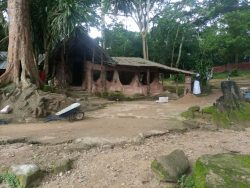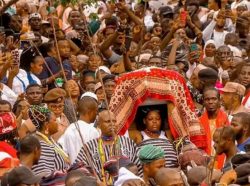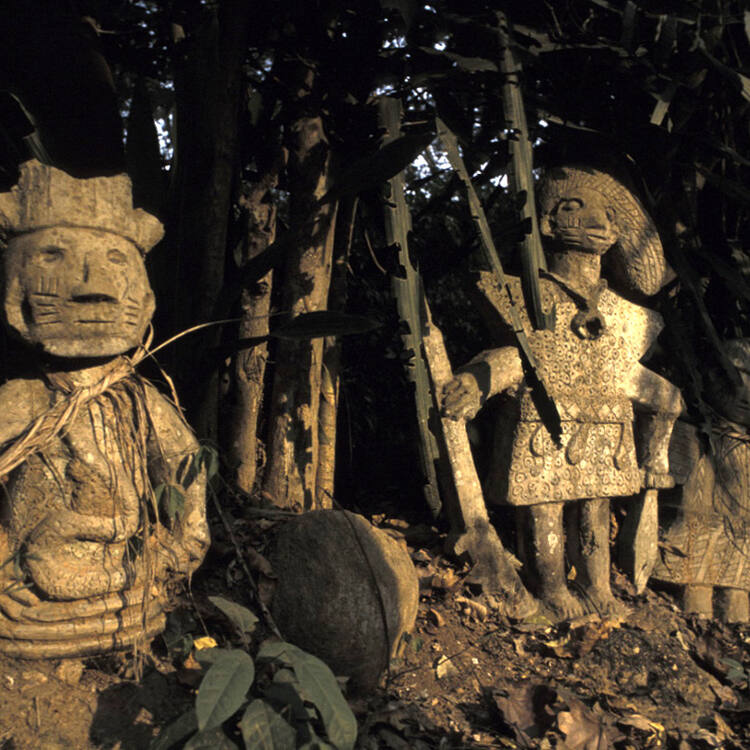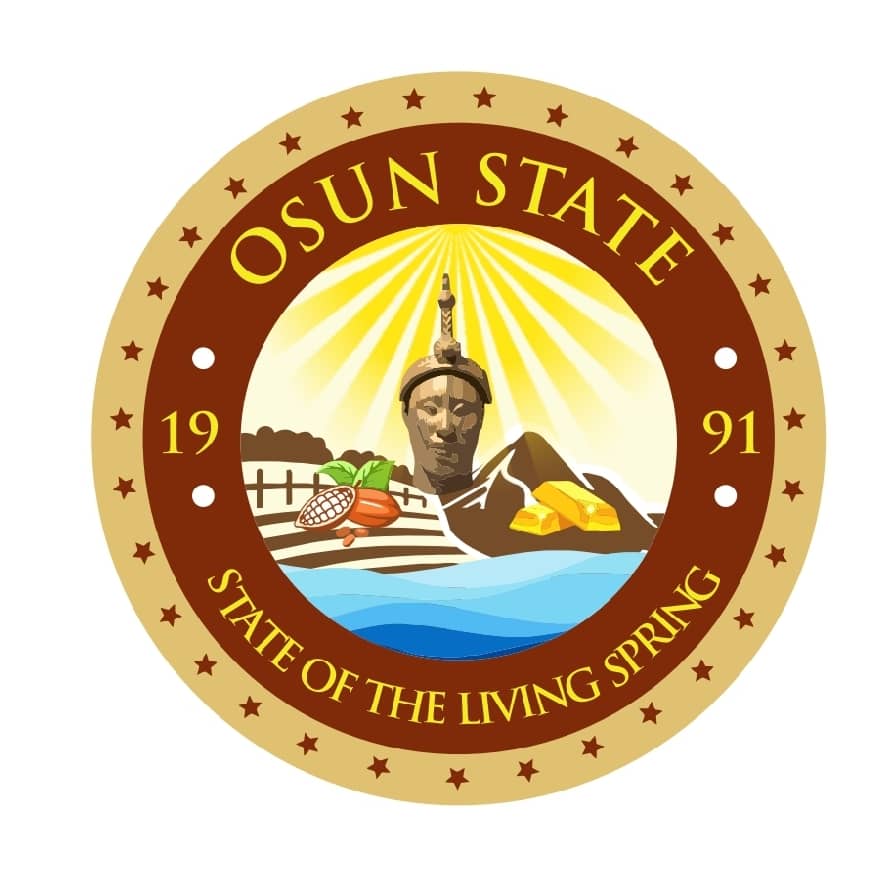Femi Siyanbola
LIKE all the monumental and most spectacular natural wonders of the world which has become a point of reference in world art history, even if the world are discovering some other wonders, one should note that some wonders before the medieval period are no longer exist, many of our fun and tourist seeking folks have found their way one time or the other to the existing natural divinely created heritages. Some of them from the primordial realm could still be mentioned here.
They are the Great pyramid of Giza, Hanging Garden of Babylon, Statue of Zeus at Olympia, Temple of Artemis at Ephesus, Mausoleum of Maussollos at Halicarnassus, Colossus of Rhodes and Lighthouse of Alexandra. Of all these wonders, only the Great Pyramid of Giza still exists and people are spending a lot of money to travel there to behold it’s greatness in Egypt.
What is worthy of note back home here is the way the monuments and the statues at the Osun Grove were painstakingly constructed by the famous late octogenarian Austria Artist, Adunni Olorisa – the Late Susan Wenger who can be likened to the two Egyptian Pharaohs, the Ramses II and the Ramses III, the third one known as the Ramses the Great died in 1225BC.


What this piece is reminding our people about is not to let the legacy of Late Susan Wenger after her demise and those who founded this monument – the Osun grove die. Why we need to rejoice and happy is the interest the former governor of Osun State, Ogbeni Rauf Aregbesola, had placed on the cultural and traditional activities of the people of Osun while he was in government.
Surreptitiously, it was through his ingenuity the foundation of Osun Grove Pavilion was laid and constructed before the twilight of his administration. It was because he demonstrated unbridled panache for creating tourists attraction destination that the UNESCO bought into it by supporting the course in kind and in cash, rehabilitated the road from Olaiya to the Grove and straight to Ita-Olokan Junction.
That erroneous believe concerning the obsessive secrecy attached to the faith of our people that our culture and tradition is fetish has been laid to rest once and for all, and since then they have been able to set the ball rolling delving deep into the chronology of the Osun Osogbo laid down tradition. This went a long way to disabuse our people’s minds that the activities they dread after all have been a source of revenue for our community.
Osun Osogbo Sacred Grove is an organically enveloped cultural landscape associated with Yoruba traditional religion and culture. Osun Grove is a world heritage site with primary rainforest vegetation covering an area of 75 hectares of land with a buffer zone of 47 hectares surrounding it. It is located along the banks of Osun River in Osogbo local government area of Osun State, South Western Nigeria.
The grove is situated on the margins of the southern forest of Nigeria on a raised parcel of land, which are about 350m above sea level. Laro and Timehin Grammar School bound the grove in the north, while in the south is bounded by the entrance of Osun State University which runs parallel to form the western boundary. In the East, it is also bounded by Osun State Agric Farm Settlement.
In Yoruba cosmology, Osun was said to have metamorphosed into river as a result of a misunderstanding between ‘Oba’ a co-wife of Sango. The Osun river takes its source from Igede Ekiti and flows through Ilesa to Osogbo town and empty itself into Atlantic Ocean. It is believed that the goddess in-habits the Grove, while the river meander within and into the Grove called Osun Osogbo Sacred grove.
The grove was discovered by an elephant hunter called Olutimehin, who hailed from Ipole – Omu in Ijesa land. This confirm the fact that the early Osogbo people were Ijesas from Ipole–Omu in Obokun local government area, where they were faced with the problem of draught, which prevented them from getting adequate supply of water for farming, cooking, bathing and all other domestic uses.


Timehin, the great hunter in one of his expeditions came across the river in the grove, and he reported back to Larooye, the King of Ipole-Omu and suggested that the king should establish his kingdom in the grove. Larooye was the Owaroki (Crown King) of Ipole-Omu – a settlement built on hilly area surrounded by a trench, dug to protect the community from external aggression.
Larooye and his people migrated from Ipole–omu to settle at the plains of river Osun, where the first palace was erected. While they were building and engaging in farming activities which involved clearing and felling of trees, one of the branches fell into the river on the DYE POT of Osun goddess, who was annoyed by this act, a loud voice came from the river shouting ‘LARO, TIMEHIN, KILODE TE FO IKOKO ARO MI” (Why did you broke my dye pot). Immediately, voices from the other spirit came out from the forests which empathized with the goddess saying ‘OSO IGBO PELE O”(Spirit of the forest we empathize with you)’. This was the genesis of the circumstance that brought the name ‘Osogbo’ by which the town is known till date.
The oral account went further to say that Oba Larooye Gbadewolu entered into agreement with Osun goddess on behalf of his people that they would respect and appease the goddess, should the goddess solve their physical and spiritual problems. The goddess (Osun) promised to multiply them if they would build a shrine for her and that a virgin girl from the royal lineage will be bringing sacrifice to her during the celebration of the agreement. This singular act of propitiation is now celebrated worldwide as Osun festival.
Larooye and Osogbo people accepted the pact and the promises of Osun goddess materialised. Beyond the monumental cultural heritage of the groove, the grove is blessed with abundant tangible and in-tangible heritages of diverse values among which are:
HISTORICAL VALUE
Osun Osogbo sacred grove is the symbol of the development of Osogbo land from the beginning to the present. The original name of the goddess OSO IGBO (Wizard of the forest) has been the name of the town OSOGBO since then. While the title of the king ATAOJA was derived from the first spiritual worship of the goddess by the founding king, in return, Osun goddess send one of the messenger to him and the king received the message from Osun messenger called “IKO (Golden fish) with his palm, this act in Yoruba means “ATEWO GBA EJA” which was later coined as ATAOJA to replace the initial Owaroki after the ceremonial act.
The root of the town (Osogbo) lay deep in the Grove, which harbors various landmark and features in form of Shrine, Temple, Trees, Animals, Markets and Rocks, places like the first and the second palace and the river. These are still active in the spiritual and physical well being of Osogbo people. Apart from regular activities related to the worship of Osun goddess and other Yoruba Gods, the Grove is the place where yearly, the Osogbo community comes to acknowledge the protection of the Osun Goddess and to renew the pact that they have with her through their participation in the Osun Osogbo Festival. They bring offering to the goddess and in – turn revive it’s energies and potency, through the collection of its ‘Water of Life’, while blacks in Diaspora often come for a pilgrimage back to their root.
ECONOMIC VALUE
The grove, which is mostly kept wild, is both a sanctuary for Osun and other lesser gods that can be consulted for protection and a natural reserve with full biodiversity that can be used for medicinal purpose. Apart from the revenue generated from the tourists that visit the site, the grove also serves as a source of income generation for the immediate community, this could be seen through the different business that goes on within the community in which the tourist, visitors and researcher patronized.
Herbal practitioners and traditional doctors procure materials for healing and other medicinal applications from the large variety of the plant species in the grove, example of this is the herbal preparation known as ‘SELERU’ which the manufacturer said, fifty percent of the ingredient used for the medicine are from the grove. It is used as a body immune booster. The traditional technology of using indigo dye (JELU), which is, believed to have originated from the goddess, is a flourishing enterprise in Osogbo. Buying and selling is a major attraction during the festival, as displaying of good services such as kegs, local fabrics, beads ornament, food and local drinks etc., and also the dancers and drummers engage in what they know best. All these provide employment opportunity and income among the communities.
The Osun Osogbo sacred grove has been a fertile ground for the creation of the “New Sacred Art” movement as a result of the encounter between an Austrian Artist and a group of local Traditional artist. It is recognized that the new sacred art instituted within the grove has revived its importance and that this has help to save it from encroachment and extinction, the way it has gone in some other Yoruba towns. The “New Sacred Art Movement” is today flourishing in Osogbo and has international recognition, with its economic benefits to the community and the public as a whole and particularly during the festival.
RELIGIOUS VALUE
The Osun Sacred grove is directly linked with the Osun Osogbo festival which takes place in August every year, bringing Osogbo people, the Yoruba both at home and Diaspora and even international tourist into a rallying point of spiritual and temporal contact with their deity such as Ogun, Sango, Obatala etc., also re-enacting the bond that exist between the king and his people, Osun goddess and Larooye, gods and men, the town and the Grove and the water of life.
The grove has kept its attribute alongside Yoruba traditional Religious activities, so far that it has been elevated to regional and Global Center for the practice of Yoruba traditional Religion. In Osun Osogbo Sacred Grove, all Yoruba have their landmark, identity and a rich sense of history, deep oral traditions which are testimonies to a living cultural tradition and civilization. Osun sacred grove is also a large sanctuary where people come to consult and communicate with their gods, worship them and being initiated as well.
EDUCATIONAL VALUE
Teachers, Students, Scholars of History, Geography, Forestry, Biology, and Art are using the grove for practical lessons. It has a high potential for the study of Yoruba culture, knowledge of its Theory systems and practical as a living sanctuary of traditional knowledge and education. The grove is also regarded as school where priests and priestesses as well as devotees learn the rudiments of worship and initiation into the traditional religion.
These traditional attributes have contributed immensely to deep knowledge about culture of Yoruba religion as well as bear testimonies to a living cultural tradition and civilization. Some of these practices have equally been exported to many parts of West African countries, Brazil, Cuba, North America, Britain, Trinidad and Tobag,o and others. It is expected that people from this part of the world will begin to come as pilgrims to the grove.
The dense rainforest vegetation of the grove with its varieties of plant and animal species has presented opportunities for the studies of Nature, Medical, Biological, Natural science, and other disciplines.
Finally, the technology of using indigo dye (JELU) is being studied, which has become a nourishing enterprise in Osogbo.
RECREATIONAL VALUE
With the continuous development of the city of Osogbo, the grove has become the closest place where a peaceful and natural environment will be accessible, without driving long distances. Therefore, the grove and the surrounding land is now being used by the people of Osogbo and tourist, as a place where one can take a breath of the natural environment and a Centre for leisure time activities. A section of the grove has been transformed into a meditation ground while some other areas are used for recreation and picnics.
Femi (Mode) Siyanbola, a Public Affairs Analyst, writes from Agunbelewo, Osogbo











